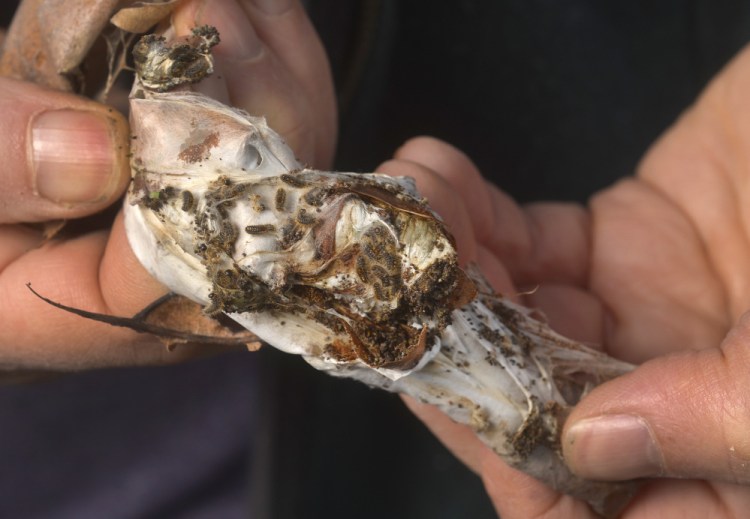Some midcoast towns are pushing for regional collaboration to combat the spread of invasive browntail moth caterpillars that have defoliated forests and left residents with painful rashes and respiratory problems.
“The footprint is intensifying and expanding. We are definitely concerned about it,” said Charlene Donahue, an entomologist with the Maine Forest Service.
Communities in the epicenter of the infestation, around Merrymeeting Bay, are sharing information and management techniques, but some officials want to consider a regional pesticide program to counter the infestation.
Browntail moths are a persistent presence on some Casco Bay islands. In the last two years, the population has surged, with caterpillars blanketing trees from Cumberland all the way to the Kennebec Valley.
Sagadahoc County has been hit particularly hard by the insect. Aerial surveys of the area this autumn showed more than 62,600 acres of woodland defoliated by moth larvae, compared to 11,000 acres damaged in 2015, Donahue said.
The most severe damage is centered in Topsham, Bowdoinham, Bath and West Bath, but researchers found damage as far away as Eliot, in southern York County. Moths have been found as far inland as Turner and Waterville, and Down East in Roque Bluffs, near Machias.

Each of the leaf clusters seen in the trees is actually a browntail moth nest. John Ewing/Staff Photographer
Browntail moth caterpillars hatch in August and spin winter nests that hold hundreds of tiny larvae on leaves high in fruit and oak trees. Caterpillars emerge in spring to feed on new leaves until they make cocoons to pupate in late June. The caterpillars are covered with microscopic hair that can produce an itchy rash or respiratory problems in humans. Loose hairs blow in the wind, are stirred up by yardwork and attach to clothing. The problem is worst in June and July, but hairs can stay in the environment for a year.
“My husband calls it airborne poison ivy,” said Ellen Baum, who lives in Bowdoinham. Baum discovered the problem two years ago, when the new leaves of her fruit trees were eaten away by caterpillars. Since then, she and her husband have gotten rashes, and they have been forced to limit their time outside and take precautions, like washing right after coming inside and using duct tape to pick tiny hairs off their skin. Many people in town have had the rash and take similar steps to prevent it, Baum said.
“It’s a bummer,” Baum said. “It affects decisions you make about how much you are outside. We are already really careful because of ticks. It makes you more cautious.”
The infestation started in 2015 and intensified this summer. A pharmacy in Brunswick reported getting at least 40 requests a day in June for rash treatment and Wolfe’s Neck Woods State Park, in Freeport, put up warning signs about the caterpillars.
As the problem worsens, some are considering a areawide approach to deal with the moths.
“We are talking to local communities, trying to come up with a collaborative effort to address the issue,” said Pam LeDuc, Topsham’s parks and recreation director. “It is pretty clear it is a regional issue.”
Bowdoinham recently created a browntail moth task force and provides information to residents, like a video explaining how to trim winter nests out of trees. The public library loans pruning tools to cut down nests.
Neighboring communities, including Bath, are sharing information, but a wider effort could involve a pesticide treatment, said Bowdoinham Town Manager Bill Post. In May, the town of Cumberland hired a company to do a targeted spray on Route 88, where there is a concentration of moths. The town of Freeport treated infested areas of Winslow Park, a public campground.
“If we undertake a ground spraying program, it doesn’t make sense to stop at the Bowdoinham town line,” Post said. “The town line isn’t a magic wall.”
Sagadahoc County town managers will likely discuss the issue at an informal meeting in December, Post said.

Bath City Manager Bill Giroux doubts a regional spraying program is feasible. “You really can’t just spray entire towns,” Giroux said. “There is really not a lot you can do other than removing nests. That is difficult on a regionwide basis.”
Demand for pesticide services has increased because of browntail moth and other invasive insects like gypsy moth and winter moth, said Terry Traver, a licensed arborist with Whitney Tree Service in New Gloucester. However, there is only about a three-week window to treat browntail moth, and rain and wind will cancel spraying, Traver said. He expects a backlog of customers his company won’t be able to help.
“We are always faced with more business than we can actually do when there is an epidemic like this,” Traver said. “You have to try and serve your customer base first.”
Browntail moths were introduced to New England in the late 19th century and have no natural predators. The last outbreak was curbed by a tree fungus that killed larvae in their spring nests. Hot and dry weather this summer blunted that effect, Donahue said.
“The fungus was there, but it didn’t do enough to make a difference,” she said.
“We don’t know what this means – will it continue to be a problem? Will it expand? Will it collapse? I have no idea.”
Send questions/comments to the editors.



Comments are no longer available on this story